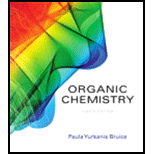
Interpretation:
The specific rotation of the given compound has to be calculated.
Concept introduction:
The pair of Enantiomers has different configurations.
Pair of enantiomers has different optical activity, which means if one will show levorotatory then the other will show dextrorotatory.
The direction and magnitude of rotation of plane-polarized light by an optically compound is measured by using polarimeter.
This rotation of polarized light is specific for a compound at specified temperature and wavelength, so it is called as Specific rotation of that compound.
Specific rotation of compound is calculated by,
Want to see the full answer?
Check out a sample textbook solution
Chapter 4 Solutions
Organic Chemistry; Organic Chemistry Study Guide A Format: Kit/package/shrinkwrap
- If degradation occurs in a specific condition, what change in the absorbance value will be expected in the wavelength/s selected? Explain your answer.arrow_forwardThe figure can rotate the plane of polarized light by 4.52 counterclockwise, 1. what is its configuration based on optical activity, 2. what is the absolute and relative configuration of the figure and 3. what is the angle of rotation of the plane-polarized light of its ENANTIOMERarrow_forwardIf a substance is known to have a specific rotation of -89.3 deg mL/g dm, what is the concentration (in g/mL) of a solution that would give an observed rotation of -25.5 degrees, if the path length of the sample tube was 2.00 dm? (Hint: Rearrange the specific rotation calculation formula)arrow_forward
- Bartleem is a chiral molecule. At 70 oC Bartleem is a liquid with a density of 0.722 g/mL. At this temperature and using a 589 nm light source with a 1 dm path length the rotation of light is found to be 71o. What is the optical rotation for Bartleem?arrow_forwardas far as i know all the chiral molecule can be used to carry out optical resolution. so i think material C also can be an option but the answer says only E can be used. could you explain why not C? Please answer very soon will give rating surelyarrow_forwardWhat is the maximum absorbance of in which caffeine absorbs?arrow_forward
- A solution is prepared by dissolving 678 mg of testosterone in 20 mL of ethanol. The sample was placed in a 10 cm long cuvette. The observed rotation of the sample at 25oC is + 13.8o. Calculate the specific turnover of testosterone, show the calculations.arrow_forwardAn unknown sugar is known to equilibrate between two forms, I and II, in aqueous solution. Thisequilibration can be followed by measuring the optical rotation of aqueous solutions of isolatedsamples of form I and II. When species I was dissolved in pure water and the optical rotation was measured, it gave aspecific rotation of [?] = +42.0°. Over time, this value decreased to a constant value of [?]= +0.2°. • When species II was dissolved in pure water and the optical rotation was measured, it gave aspecific rotation of [?] = -54.0°. Over time, this value decreased to constant value of [?]= +0.2°. • In each case, both forms I and II were shown to be present in the mixture at the end of theexperiment. Calculate the ratio of the two forms I and II present at equilibrium and comment on anyassumptions made in making that calculation.arrow_forward(S)-2-Bromobutane has a specific rotation of +23.1°. Suppose that a solution is made by dissolving 20.00 g of (S)-2-bromobutane in 1.00 L total solution. What would be the measured rotation of plane-polarized light sent througha 10.00-cm tube containing that solution?arrow_forward
- What could be the observe rotation of a 0.87 M solution composed of a sample which has a MW of 253.62 placed in a17.69 cm sample bulb. The computed specific rotation at -28.31 no need to put the unit answer in 2 decimal places..arrow_forwardWhen 0.018 g of cholesterol is dissolved in 1.00 mL of ether and placed in a sample cell 10.0 cm in length, the observed rotation at 20 degrees (Using the D line of sodium) is -0.0567 degrees. Calculate the specific rotation of cholesterol. specific rotation= [α] =arrow_forwardHere is the visible absorbance spectrum and electromagnetic spectrum. 1. Determine which molecule (a,b,c, or d) has the smaller HOMO-LUMO gap. Briefly explainyour reasoning. rememeber more conjugation is a smaller gap.arrow_forward
 EBK A SMALL SCALE APPROACH TO ORGANIC LChemistryISBN:9781305446021Author:LampmanPublisher:CENGAGE LEARNING - CONSIGNMENT
EBK A SMALL SCALE APPROACH TO ORGANIC LChemistryISBN:9781305446021Author:LampmanPublisher:CENGAGE LEARNING - CONSIGNMENT
